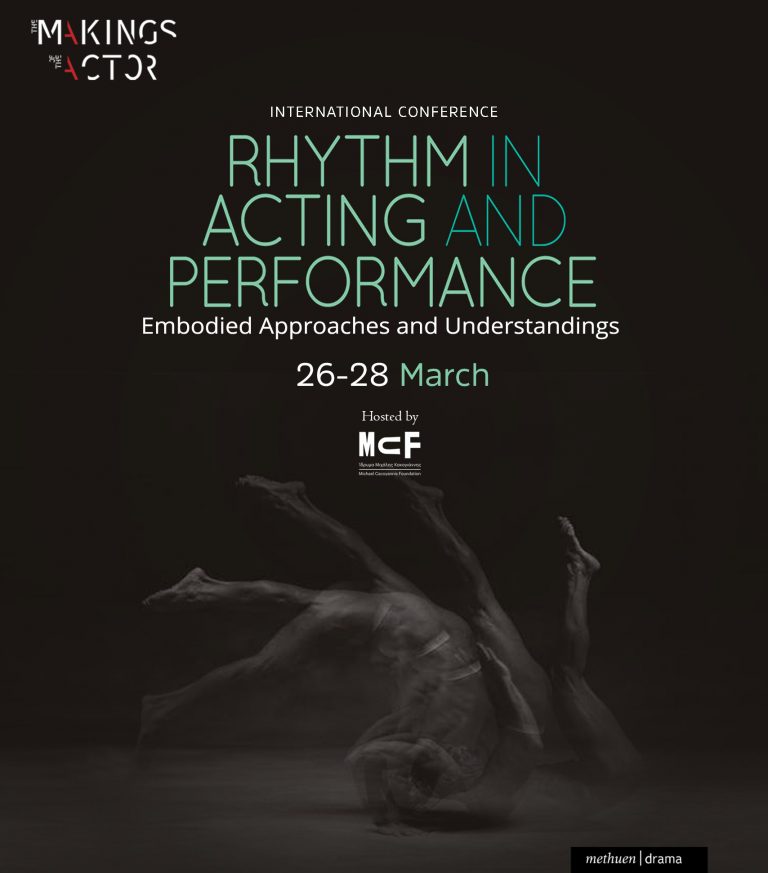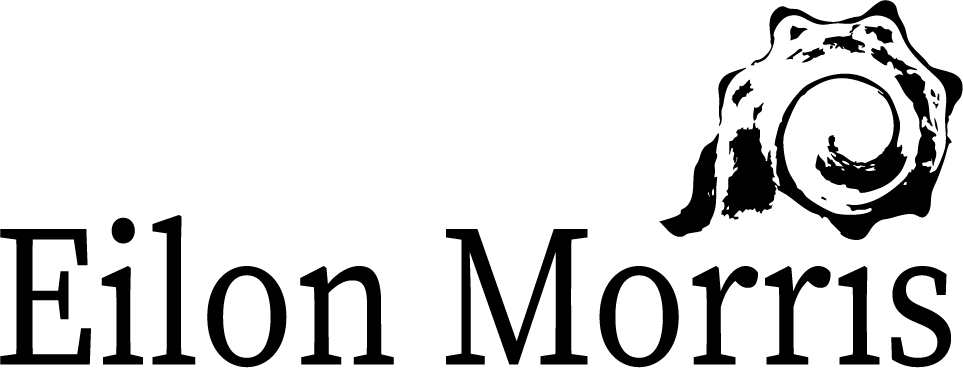**DEADLINE FOR PROPOSALS EXTENDED UNTIL 22nd FEBRUARY**
CALL FOR PAPERS and WORK DEMONSTRATIONS
Hosted by Michael Cacoyiannis Foundation
26-28 March 2021

Keynote Speakers
Outline
Topics
Submissions
Fees
Rhythm in Acting and Performance is an International Conference held under the auspices of The Makings of the Actor, the Michael Cacoyiannis Foundation, the Labanarium, Leeds Conservatoire and Hellinoekdotiki, organized by Dr Eilon Morris, from Leeds Conservatoire and OBRA Theatre, with the support of Post-doctoral Researcher Dr Kiki Selioni, Royal Central School of Speech and Drama, University of London.
This Conference is part of a series of international events under the aegis of The Makings of the Actor. The mission of The Makings of the Actor project is to gather international practitioners and researchers, from diverse fields of performance practice and scholarship, to develop and disseminate (through conferences and workshops) an evolving performance pedagogy that addresses the needs of present and future actors.
Keynote Speakers:
Paul Allain – Professor of Theatre and Performance and Dean of the Graduate and Researcher College at the University of Kent, UK.
Carla Fonseca – Artistic Director of Jornadas Internacionales el Ritmo en las Artes (JIRA) and Professor of Dalcroze Eurhythmics at the Drama Department of Universidad Nacional de las Artes (UNA), Buenos Aires, Argentina.
In recognition of both the global reach of this theme and the expansive network of interested practitioners and scholars, as well as the impact of the current pandemic, participants are invited to take part either in person or virtually. Conference proceedings will be live-streamed; papers, and where appropriate workshops and demonstrations, can be presented remotely.
Outline
The topic and practice of rhythm has inspired and intrigued performance practitioners and theorists throughout the ages, from the poets and philosophers of ancient Greece, to the pioneering theatre practitioners of the late nineteenth and early twentieth century, and onwards to post-modern and post-dramatic approaches to acting, movement, devising, designing and directing. Aristotle identified rhythm as the performer’s primary means of imitation in both comedy and tragedy, with rhythm also seen to bring order and form to what was otherwise ‘unbounded’ and therefore ‘unpleasant’. The theatre director Vsevolod Meyerhold exclaimed that ‘the gift of rhythm’ was ‘one of the most important prerequisites for a director’, with Peter Brook echoing this when he stated, ‘at the heart of a fine performance there is always rhythm’. Perhaps the greatest appeal of rhythm in performance is its immediacy; going beyond our sense of reason, rhythm achieves moments of deep-felt empathy and connection between performers and audiences. Yet despite a widespread identification of rhythm as a central aspect and tool within acting and performance, the nature and practice of rhythm both remain mysterious to many practitioners and scholars today, with vastly contradictory notions of rhythm co-existing within this field, and little in the way of research and discourse being given over to this subject.
In the book, Rhythm in Acting and Performance: Embodied Approaches and Understandings, Eilon Morris writes, ‘Under scrutiny, the subject of rhythm reveals a nature that is both evasive and porous’. As such, the ways we approach and research this subject require particular attention and consideration. Published in 2017, Rhythm in Acting and Performance was written as a direct response to what Morris viewed as the absence of attention as well as the general confusion around this topic within the fields of acting and performance. In the introduction to this book Morris writes:
I must admit that in my own experience as a performer, when a director mentions ‘rhythm’, there is a part of me that leans in with excitement and another part that shrinks back with a sense of dread. For seldom am I completely sure that I (or they) know precisely what they are referring to. Are they talking about the speed or the phrasing of my movement or voice? Am I being asked to make my work more structured and accentuated or more fluid, varied and dynamic? Or are they referring to any number of other specific technical, metaphorical or metaphysical meanings of rhythm, related to music, poetry, dance, nature, etc? Or are they commenting on a more general sense of timing or composition? … However, despite the confusion, this word still seems to stick, finding continued usage and interest throughout a broad range of practices and disciplines. Even though rhythm is seldom defined within the practical context of performance making, there often exists what might be best understood as a tacit knowledge that informs a performer’s engagement with rhythm. As Brook and Meyerhold pointed out, even if we cannot define it, we still do it, or at least know when it is there or not. This is a knowledge that exists in the practice itself, in the doing and the making of performance and in the shared sets of understandings that emerge from the creative processes of collaboration. These embodied understandings resist definition and often take the form of shorthand remarks tossed about within a rehearsal process, evolving and integrating new meanings as the practices themselves change and develop over time. Instead of viewing rhythm as a fixed concept which we can point at and examine, rhythm might be better understood as a constellation of associations, understandings and embodied practices, of which we can enquire and explore. (pp4-5)
Weaving together theory and practice this text gathers a range of historical and contemporary approaches to performance and examines the ways rhythm has been and is being approached within each of these contexts. Rather than attempting to give a ready made definition of rhythm, this text lays out both the diversity and commonality of understandings found within this field. Driven by practical questions of how performance practitioners work with and through rhythm, this book gives particular attention to the ways practice and knowledge interact to inform our understandings of rhythm. These understandings go beyond theoretical frameworks, systems and methodologies, with our sense of rhythm in performance arising from embodied processes and exchanges taking place in everyday life, training, rehearsals and performance.
Taking Rhythm in Acting and Performance as both a framework and provocation, this conference will delve into its various themes and practices, offering a platform for practitioner and scholars to share and reflect on their perspectives and insights into rhythm within acting and performance. Through presentations, work demonstrations and discussions, we will explore common themes as well as differing understandings and approaches to rhythm in this field.
We welcome submissions from practitioners and scholars including acting/voice/movement/dance teachers, acting coaches, theatre and performance practitioners, actors, directors, dancers, choreographers, playwrights/script writers, film directors/makers, composers, training practitioners, designers, theatre and dance researchers and academic researchers within various aspects of practice and performance theory.
For a more detailed overview of this text please visit
Rhythm in Acting and Performance
and
https://www.bloomsbury.com/uk/rhythm-in-acting-and-performance-9781472589866/
Topics
Using the chapters of Rhythm in Acting and Performance as a framework for this conference, the themes and practices this event seeks to address include, but are not limited to:
PART ONE Establishing a Pulse
What is Rhythm? An Open Question
The etymologies of rhythm;
Themes of ‘natural’ and ‘organic’ rhythm;
Rhythm as a universal language;
Authenticity and real-time;
Rhythm as a means of:
– accessing specific qualities of expression and mood
– communicating with an audience
– building ensemble
– developing an individual and shared performance language
– establishing expressive territories
PART TWO Stanislavski on Rhythm
Tapping Emotions: The Ins and Outs of Tempo-Rhythm
– Tempo-rhythm as a psychophysical technique in training and rehearsals;
– Tempo-rhythm and emotions
– Inner and Outer Tempo-rhythm
– the influence of Eurhythmics and Opera
PART THREE Structure and Spontaneity
Rhythms of improvisation and play
Suzanne Bing: Music and Games in Actor Training
Vsevolod Meyerhold: Rhythm not Meter
John Britton: Smashing the Ensemble Groove
Anne Bogart and Tina Landau: Non-Hierarchical Viewpoints
PART FOUR The Ecstatic Performer
Rhythm and Altered States of Consciousness: Entrainment and Communitas
Rhythmic entrainment
Ecstatic states and transformation through rhythm
Jerzy Grotowski: Seeking Pulse, Movement and Rhythm
Nicolás Núñez: Becoming Present
Eilon Morris: Orbits, Polyrhythm and Simultaneity
PART FIVE A Plurality of Voices
Rhythming Words: Where, How and Why
Meaning arising from rhythm
Creating spaces: Conversations with Judith Adams and Karen Christopher
The Poetry of the Breath: Conversations with Bruce Myers and Kate Papi
The Tune is a Framework: A Conversation with Chris Coe and Frankie Armstrong
Additionally, the conference would be interested to hear from practitioners and scholars offering reflections on rhythm in acting and performance within cultural and historical contexts not covered by this book, as well as research that highlights the role of rhythm in relationship to accessibility and diversity in performance practices and perspectives on rhythm within design practices including lighting, sound, projection and scenography. Presentation in the form of research papers, teaching demonstrations, and short films/work demonstrations are welcomed.
Submitting Proposals
For papers, please send your abstract of 200 words for your oral presentation in Word doc form, including title, institutional affiliation, your brief CV and email address. The paper presentations will be 20 min, followed by a 10 min discussion with the audience/participants. We accept submissions for online paper presentations.
Submissions of teaching demonstrations must be in English and can be up to 4 pages (including references and figures) in a word doc form, including title, institutional affiliation, your brief cv and email address. The first 2 pages are expected to describe your approach. The third and fourth pages are expected to be used for images, references, and technical requirements. You can expect wireless network access. 4-6 students will be provided for all accepted demonstrations. The demonstrations allow practitioners/researchers to demonstrate their works in teaching in a dedicated session of 90 – 150 min., followed by a 20 min discussion with the audience/participants. We accept submissions for online teaching demonstrations.
We will also accept applications for shorter (pre-filmed) work demonstrations (10-15 min) which focus on one or two specific exercises or rhythmic aspects within a performance or training practice. Submissions for these practice snapshots should include a 200-word abstract with details of the work to be shared along with a brief biography of the practitioners involved.
Please send your submission by the 22nd February 2021 to:
Acceptance Notification: 22nd February 2021
If an official invitation is required earlier for research funding purposes, please contact Info@themakingsactor.com and ensure that you submit your abstract as early as possible.
Paper presentations, teaching demonstrations will be held between 26 and 28 March 2021
Conference Registration fees:
All those attending the conference will get a 35% off the cost of the book Rhythm in Acting and Performance. Institutions with access to Bloomsbury Methuen’s Drama Online will also able to access this text electronically for free.
Paper presentations fees: 120€
Teaching Demonstration fees:
90 min. 120€
120 min. 220€
150 min. 250€
Attendants fees: 75€
Student & unwaged fees: 50€
Non-affiliated practitioners and independent scholars whose pre-filmed work demonstration/practice snapshots are selected for inclusion in the conference will also receive a book discount and will not be required to pay an attendance fee.
